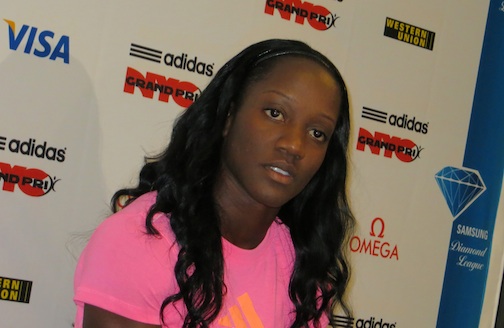Above: Kelly-Ann Baptiste (CJ Photo)
By Alexander Britell
Kelly-Ann Baptiste headlines a group of sprinters carrying Trinidad and Tobago’s medal hopes at this summer’s London Olympics. Baptiste, a former sprinter for Louisiana State University, competes in the 100m and 200m races, and represented Trinidad at the Beijing Olympics in 2008. This year, however she has her eyes firmly trained on a medal. But beyond the Games, she wants to leave a legacy for the country’s young female track and field athletes. Caribbean Journal talked to Baptiste at the Adidas Grand Prix (where she finished fifth in the 100m) in New York last week about her training, the state of women’s track and field in Trinidad, and wearing the red, white and black in London.
What does it mean for you to represent Trinidad on the global stage?
I think, for me, it means a lot from the female perspective, because, as you know, Ato Boldon and Hasely Crawford have flown the flag for the men over the years. So for me, just to be a female and represent my country, it’s a big day for me, because I am able to show other females that they can do it too. So I’m just trying to leave a legacy, so the other Kelly-Anns, or whoever comes up behind me, can see themselves in the same position and do the same things or even better.
How has women’s track and field developed over the years in Trinidad?
I think it has developed over the years. I think over the years, from the ages of 11 to 18, we’ve had great athletes, but they’ve all fallen off after that. So into the senior ranks, it has developed a lot more, like Semoy Hackett at LSU [who also competed in Beijing in 2008] and Kai Selvon (who will also head to London) at Auburn. I think that young group of women has been paving the way for us to be more competitive as females on the world stage.
Are there other female track and field athletes whom you look up to in to the Caribbean?
Unfortunately, not in my country. But, and it’s weird that I now compete against her, but I grew up looking up to Veronica Campbell. And so I looked up to her for a while, and I admired the way she ran, and, to be honest, that was pretty much it. A lot of people I looked up to were Jamaicans, just because they had a rich tradition of track and field. It wasn’t that I didn’t want to look up to anyone else – obviously there was Ato Boldon, but as a female, you want another female to relate to, so I related to the female Jamaican sprinters for some of that.
There will obviously be a strong Caribbean presence at the Olympics. Is there any kind of intra-Caribbean rivalry?
I don’t really think about it that much. Because as much as you all wear different uniforms, when you step on the line, it’s always against each other. It’s not really intra-Caribbean competition, but it’s competition against yourself and the other person. And it doesn’t matter whether they’re wearing Jamaican colours or USA colours — it’s just that individual. Because outside of the Olympics, and outside of the World Championships, when we race on the circuit, it’s just a person. So I just take it the same when I race, whether it’s in New York, or the Olympics or the world Championships.
What do you think will be going through your mind when you’re wearing Trinidad’s colours at the Olympics in London?
I believe I will be thinking about what a great honour it is to be able to line up in the final as a Trinidadian female, and to have the opportunity to create history, and that’s probably one of the things I’ll be thinking about when I’m out there.
What is your biggest priority ahead of London?
Staying healthy and taking each race as a training effort, in the sense of, as much as I want to go out there and win, it doesn’t mean that the whole world is over or my Olympics dreams of having a gold medal are over. It’s just over the next few months to be able to make it right and perfect on that day in London.
